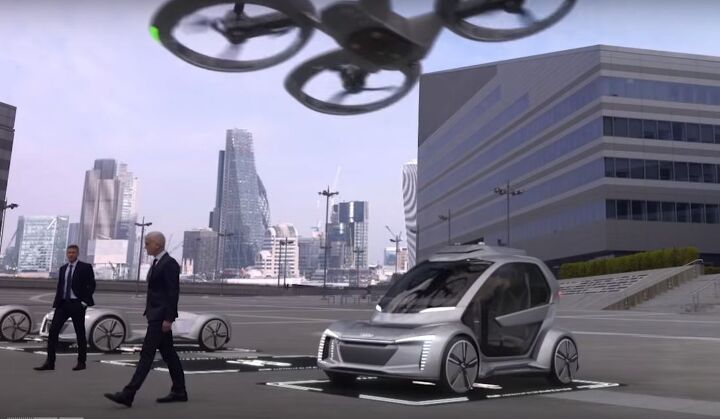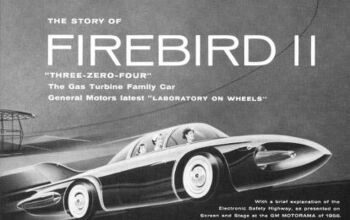Don't Hold Your Breath Waiting for an Audi Flying Car

Few topics anger this writer as much as the so-called “flying car.” Much like the massive airships Popular Mechanics assured us were right around the corner back in the mid 1990s, the flying car seems more like a tech writer’s fever dream than a viable and imminent form of transport.
For starters, they’re mainly just helicopters, though some aircraft would provide “last mile” service to the rider’s final destination using a motor and steerable wheels. The vehicles/aircraft would be autonomous, too. It sounds like a regulatory nightmare awash in red tape.
One company pursuing such a product is Audi, though the automaker recently admitted its dreams aren’t even close to becoming a reality. It’s now paring things back.
Speaking to Roadshow, Audi admitted this week that it’s deploying the drogue chute on its plans for a flying taxi, built with help from aerospace partner Airbus and Italdesign. The automaker stated it is “currently working on a realignment of our urban air mobility activities and [has] not yet made a decision on possible future products.”
Flying car taxis, Audi said, will not become a reality for “a very long time.”
That said, Audi remains committed to the idea, saying the recent pair-up between fellow Volkswagen Group subsidiary Porsche and Boeing could prove beneficial to its own efforts. The company might choose to piggyback on Porsche and Boeing’s development of a flying taxi.
Last year, Audi and its partners released a concept, the Pop.Up Next.
The idea’s current form is modern, but the overall idea of shuttling passengers to, say, downtown New York City from nearby airports is nothing new. New York Airways once flew passengers from JFK, LaGuardia, and Newark to helipads in Manhattan, including one atop the former Pan Am Building. It was there that a Sikorsky rotor blade made prosciutto of five unfortunate souls, cancelling all further landings on the rooftop pad. The airline closed its doors in 1979 following another fatal crash.
Nowadays, the flying taxi vision incorporates a scaled-up drone with enclosed blades and a passenger compartment suspended below it. After touching down on a waiting autonomous, EV vehicle platform, the rotor array would detach, allowing the passenger pod and attached platform to drive to its destination. Other concepts, like the one envisioned by Porsche and Boeing, resemble a tailless airplane with vertical takeoff capability. Electricity would provide the propulsion, and final-mile travel would not be offered. Unlike Audi, the two partners feel a hub-to-hub solution makes the most sense.
Passengers can grab an Uber for that last jaunt to the front door.
Speaking of Uber, Uber Air is a thing, with the money-losing ride-hailing company planning a very helicopter-like electric aircraft to transport people in a similar fashion. Test flights will supposedly get off the ground in the coming year, with commercial service pegged for 2023.
If this all sounds like a mobility solution for the wealthy, you’re not far off. Airline travel, both with lighter-than-air airships and later fixed-wing transport, started off as a plaything of the rich. It was only after aircraft costs fell and passenger capacity rose when an ordinary person could afford to buy an airline ticket. Thank the Douglas DC-3 for opening up that mode of transport for the average Joe.
Yet automakers like Porsche, well-versed in offering transport for the wealthy, aren’t saying such a service is anything but. The automaker calls it another form “premium mobility.”
As we all know, all things mobility are hungrily eyed by automakers eager to find new revenue streams in a cooling auto market. From driverless Chrysler Pacifica fleets to batwing-shaped autonomous air taxis, few mobility solutions of dubious revenue potential are off the table.
[Image: Italdesign, Boeing]

More by Steph Willems
Latest Car Reviews
Read moreLatest Product Reviews
Read moreRecent Comments
- Tane94 Awaiting the EV3 unveil this month. Kia continues to lead, though I will miss the Soul
- Jeanbaptiste I know this will never be seen, but the real answer is NO Government mandated tech. The reason why is that when the government mandates something, we miss out on signals that the free market will give to weather or not people actually want this or that this tech would actually help. It's like mandating AM radio for cars when people could just buy a $10 am radio if they really like am so much.
- 28-Cars-Later $12K? I needed a good laugh.
- EBFlex Wait...the feds are claiming that inflation was not FJBs fault 6 months prior to an election where he is massively losing in the polls in every single category?Eyebrow raised.
- MaintenanceCosts Most of the article after the blockquote is Posky laboring mightily to somehow blame this clearly anticompetitive and oligopolistic conduct on the big bad government.I look forward to some of the usual commenters explaining to us that, actually, the oil industry is a cuddly teddy bear and the real villain is people trying to sell us cars that don't use oil.


































Comments
Join the conversation
"the massive airships Popular Mechanics assured us were right around the corner back in the mid 1990s" It's worse than that - spurred by some forum discussion or other, I did a Google Books search of Pop Mech covers, and found proclamations of incipient airship domination roughly every five to ten years from the 1930s until the early 2000s. They just couldn't resist.
I don't see flying cars as something most Audi customers would buy. How are they going to screech around the neighborhood, flip people the bird and blow stoplights in the sky?